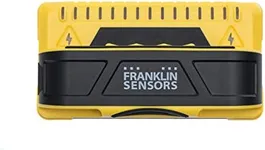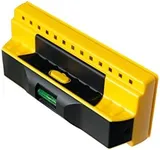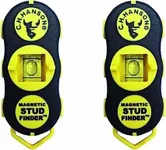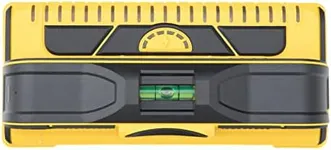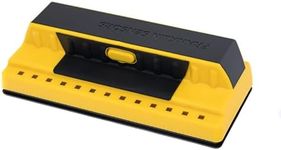Buying Guide for the Best Stud Sensors
When it comes to picking the right stud sensor, it's important to understand the key features and specifications that will help you find the best fit for your needs. Stud sensors are essential tools for locating studs behind walls, which is crucial for tasks like hanging heavy objects or installing fixtures. By understanding the different specifications and how they relate to your specific needs, you can make an informed decision and choose a stud sensor that will serve you well.Detection DepthDetection depth refers to how deep the stud sensor can detect objects behind the wall. This is important because walls can vary in thickness, and you need a sensor that can accurately detect studs at the depth you require. Detection depths typically range from 0.5 inches to 1.5 inches or more. For standard drywall, a detection depth of around 0.75 to 1 inch is usually sufficient. If you are working with thicker walls or materials, you may need a sensor with a greater detection depth. Consider the types of walls you will be working with most frequently to determine the appropriate detection depth for your needs.
Detection ModesDetection modes refer to the different types of materials and objects the stud sensor can detect. Common modes include wood stud detection, metal detection, and live wire detection. This is important because it allows you to locate not only wooden studs but also metal studs and electrical wiring, which can help prevent accidents and ensure accurate placement of fixtures. Basic models may only offer wood stud detection, while more advanced models include multiple modes. If you frequently work in environments with various materials, a sensor with multiple detection modes will be more versatile and useful.
AccuracyAccuracy is a measure of how precisely the stud sensor can locate the edges and center of a stud. This is crucial for ensuring that you are drilling or nailing into the correct spot. Higher accuracy means fewer mistakes and a more reliable outcome. Accuracy can be influenced by the quality of the sensor and its calibration. Look for sensors with features like automatic calibration and clear indicators for the center and edges of studs. If precision is important for your projects, prioritize sensors known for their high accuracy.
Ease of UseEase of use encompasses how user-friendly the stud sensor is, including its design, interface, and additional features. This is important because a sensor that is difficult to use can lead to frustration and errors. Features that contribute to ease of use include a clear display, audible alerts, ergonomic design, and simple controls. Some models also offer visual guides or LED lights to help you track the sensor's movement. If you are new to using stud sensors or prefer a straightforward experience, look for models that are highly rated for their ease of use.
Battery LifeBattery life refers to how long the stud sensor can operate before needing a battery replacement or recharge. This is important because a sensor with a short battery life can interrupt your work and require frequent maintenance. Battery life can vary significantly between models, with some offering extended use on a single charge or set of batteries. Consider how often you will be using the sensor and whether you prefer a model with rechargeable batteries or standard replaceable ones. For frequent use, a sensor with long battery life or rechargeable options may be more convenient.
